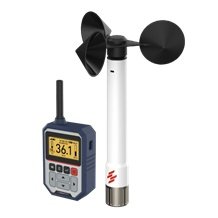What Is an Anemometer?

Despite their tricky name, anemometers are surprisingly common tools. If you are not absolutely sure what an anemometer is, then this article is for you!
Anemometer Definition
An anemometer is a device that measures wind speed, which makes these devices indispensable for a wide variety of applications.
The Main Types of Anemometer
There is an extensive selection of models of anemometer available at Instrument Choice. Each design has different properties and measurement methods suited to specific applications. Below, our scientists have detailed each of these types along with representative product examples.

Figure 1 Wind Vane
1. What Is a Vane Anemometer?
A vane anemometer measures wind speed via an impeller, propeller or turbine. A vane anemometer must be faced in the direction of the wind source to take a measurement; this forces the vane's blade to start spinning. The device measures each time the magnetised blade passes the reed switch within a specific timeframe and converts this to a windspeed measurement.
Vane Anemometer Applications:
Vane anemometers are a popular choice for;
- Various outdoor monitoring tasks, including; building sites and agricultural applications; and
- HVAC applications such as monitoring exhaust flow and exhaust hoods.

Product Example: TSI 5725 VelociCalc Rotating Vane Anemometer
|

Figure 2 Wind Cups
2. What Is a Cup Anemometer?
Cup anemometers generally consist of three cups attached to horizontal arms mounted on a vertical rod. As the wind velocity increases, the cups spin freely. Like vane anemometers, a sensor or reed switch measures the number of rotations in a time frame and converts the rotation measurement into a wind speed metric. However, unlike vane anemometers, cup anemometers do not need to be facing the wind force to take a wind speed measurement.
Cup Anemometer Applications:
Cup anemometers generally have a broad measurement range making them well suited to outdoor environments. Applications for cup anemometers include measuring wind speed at:
- Construction sites
- Mines
- Building sites, particularly when cranes are used
- Farms; and
- Schools.

Product Example: WR-3 Plus Wireless Anemometer Kit
|

Figure 3 Hot wire anemometer
3. What Is a Hotwire Anemometer?
Hotwire anemometers work using the principle that the cooling effect of wind flow extracts heat. They comprise a fine, electrically heated wire on the sensor that’s heated slightly above ambient temperature. The device will keep the wire at a constant temperature whenever any airflow starts to cool it. The meter will then measure the amount of current needed to keep the wire’s temperature constant and convert this to an air velocity reading.
Hot Wire Anemometer Applications:
Hotwire anemometers perform best in environments with relatively stable and constant temperatures, for example:
- Checking flow foods
- Exhaust monitoring; and
- Various other HVAC applications.

Product example: Testo 405i Smart Hot Wire Anemometer
|

Figure 4 Ultrasonic anemometer sensor
4. What Is an Ultrasonic Anemometer?
Ultrasonic anemometers use sonic pulses to precisely measure wind speed. Sonic pulses are created and sent via sensors on either side of an opening on the anemometer. As wind speed increases, the sonic pulses ability to cross the junction is compromised. The anemometer uses this information to calculate wind speed.
Ultrasonic Anemometer Applications:
An ultrasonic anemometer generally has no moving parts and requires very little maintenance, making them item wind measuring devices for long term and remote deployments, including;
- Mine sites
- Construction sites
- Tower cranes
- Weather buoys; and
- In environments with salty air or large amounts of dust could affect the accuracy and reliability of traditional cup or vane anemometers.

Product example: Sonic Anemometer
|

Figure 5 Pitot Tube
5. What Is a Pitot Tube Anemometer?
Pitot Tube Anemometers are suitable for measuring mid-range to high-velocity and temperature airflow. A pitot tube design generally has two holes. The first hole at the front faces the wind direction and measures stagnation pressure (i.e., the static pressure at a stagnation point in a fluid flow). The second hole is located on the side of the pitot tube and measures static pressure (i.e., the resistance to airflow in ductwork or other components). These devices calculate the difference between these two pressure measurements to generate a dynamic pressure reading and convert that reading to a wind velocity measurement.
Pitot Tube Anemometer Applications:
Pitot tube anemometers are suitable for use in high temperature and high wind velocity environments, for example, monitoring:
- HVAC/R systems
- Exhaust vents; and
- Flow hoods

Product example: Pitot Tube Anemometer with Differential Manometer
|
Conclusion: What is an Anemometer?
Unlike the pronunciation of these instruments, the answer to the question “What is an Anemometer?” is straightforward. Anemometers are super useful, easy-to-use devices used to measure wind speed for a host of industry, community, educational, and agricultural applications.
Need advice or assistance finding the best anemometer for your application? Speak with an Instrument Choice Scientist: Call 1300 737 871 or email [email protected].
Also interesting
At Instrument Choice, we proudly stock over 150 brands of scientific instruments and laboratory equipment. Our mission is to provide our customers with the widest selection of scientific instruments, all in one place, so you can measure anything and measure everything.
To help you find the best products to suit your application, our scientists regularly spotlight new brands so you can better know what they offer you. This edition features Gallagher and their expertly crafted and highly versatile range of accurate, wireless tank monitoring systems.
Click here to discover the Gallagher Wireless Tank Monitoring Systems

LogTag USB Temperature loggers are among some of Australias most trusted USB loggers. These intelligent loggers feature a built-in USB interface that provides you with a quick and easy connection directly to your computer.
In this article, our scientists detail the LogTag USB Temperature Logger range and compare the difference between the three units.
Get your guide to LogTag USB Temperature Loggers

